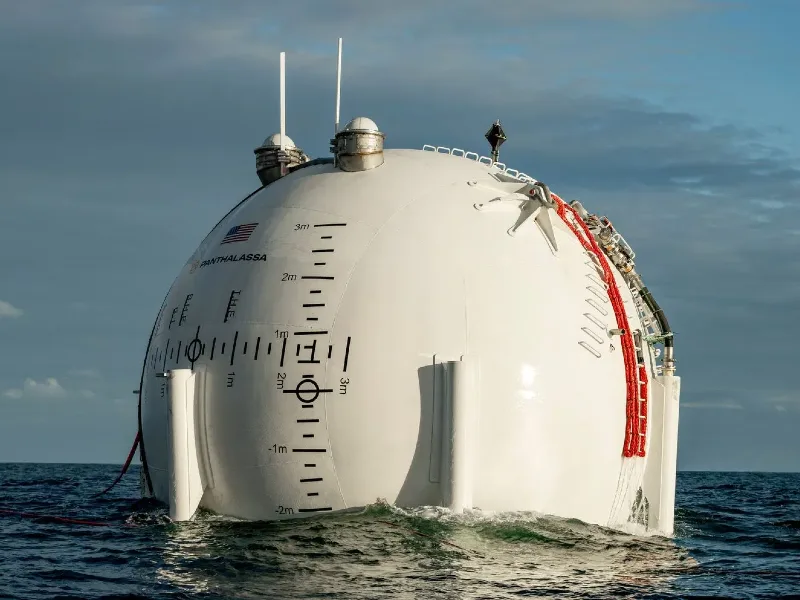In the serene waters off the coast of Everett, Washington, a spectacle that seemed more akin to a scene from a science fiction novel has been captivating onlookers and sparking a frenzy of speculation on social media. The source of this intrigue? A mysterious, meandering white object that has been seen being towed around the Puget Sound area.
This 200-foot tubular marvel, known as Ocean-2, isn’t a remnant of an alien civilization or a secret government project but a prototype for a groundbreaking renewable energy capture buoy, crafted by the innovative minds at Panthalassa, an Oregon-based startup.
Panthalassa, nestled in the vibrant city of Portland, has been the birthplace of Ocean-2, a testament to human ingenuity and the relentless pursuit of clean, affordable energy. The startup’s vision is to harness the boundless energy of the ocean, transforming the way we think about renewable resources.

Ocean-2’s journey through the waters of Puget Sound wasn’t a casual voyage but a meticulously planned sea trial, spanning three weeks, aimed at testing the prototype’s capabilities and bringing it one step closer to revolutionizing our energy landscape.
Garth Sheldon-Coulson, a co-founder of Panthalassa, shed light on the object’s purpose and its recent activities. “We’ve been out running a sea trial for three weeks, so this buoy is just coming back now,” Sheldon-Coulson explained.
The prototype’s temporary residence in the waters was part of its journey back to Portland, where it will undergo further analysis and preparation for the next phases of its development.

As the curiosity of the local community peaked, Sheldon-Coulson provided clarity on the buoy’s operational stance. While in transit, Ocean-2 adopts a horizontal orientation, but when activated, it stands vertically in the water, with its bulbous part floating at the surface and the remainder submerged, tapping into the ocean’s energy. This innovative design was witnessed during its sea trial in the Strait of Juan de Fuca, building on the experience gained from its predecessor, Ocean-1, which embarked on a similar mission from Port Angeles in 2021.
“We tested our electricity generation technology, and also tested satellite communication and all of the things that we need to make the technology work and capture energy,” said Sheldon-Coulson.

Panthalassa isn’t just a company but a collective of visionaries from diverse fields, including aerospace, naval architecture, and software development, united by a common goal to unlock the ocean’s energy potential. With around 70 employees, the company has spent eight years refining its technologies, transitioning from research and development to the brink of commercialization.
The intrigue surrounding Ocean-2 reached a climax when locals, including Bill Rucker and his friends, witnessed the prototype’s movement during the Super Bowl Sunday. Theories abounded, with guesses ranging from capsized sailboats to mobile communication towers, echoing the suspense and sudden turns of the game itself.
More To Discover
- The Southern Hemisphere Is Drying Out, Scientists Confirm, And That’s A Big Problem For Us All
- Reviving An Elusive Predator: The Bold Mission to Save Texas’ Endangered Ocelots
- Sweet Sorrow: Climate Crisis Drives Sugar Prices to Record Highs, Impacting Desserts Worldwide
- Major US Egg Producers Found Guilty in Price-Fixing Lawsuit
“On Ocean-1, we were making green hydrogen on the device. You can make green hydrogen by splitting water, and that’s a fuel that can be used to replace fossil fuels,” said Sheldon-Coulson.
As Ocean-2 prepares to depart Everett and continue its journey towards revolutionizing renewable energy, it leaves behind a legacy of curiosity, inspiration, and a glimpse into a future where the ocean’s power is harnessed for the betterment of humanity. With Ocean-3 already in the pipeline, Panthalassa’s voyage is just beginning, promising a horizon filled with innovation, sustainability, and energy solutions that once seemed beyond our reach.





















